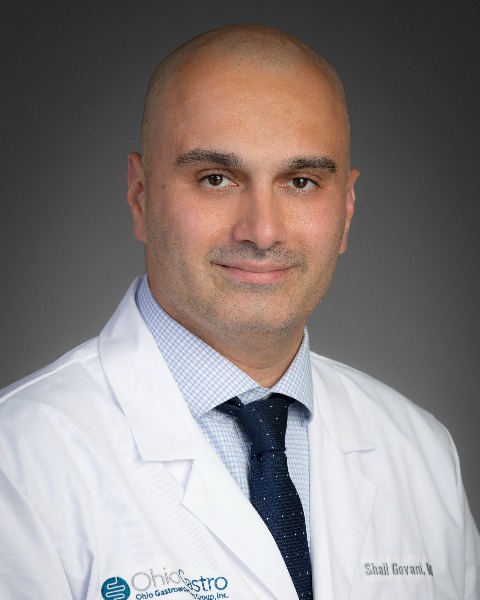Oral Paper Presentation
Annual Scientific Meeting
Session: Plenary Session 2B - Colon / General Endoscopy / GI Bleed / Practice Management
36 - Automated Methods for Post-Procedure Follow-Up are Effective and Reduce Workload
Tuesday, October 29, 2024
9:50 AM - 10:00 AM ET
Location: Terrace Ballroom 2-3

Shail Govani, MD, MSc
Ohio Gastroenterology Group
Columbus, OH
Presenting Author(s)
Shail Govani, MD, MSc1, Debbie Sauls, RN, BSN1, Billee Corwin, BSN, RN2, Sara Dayton, 1, Raghuram Reddy, MD1, Bruce Hennessy, MD1
1Ohio Gastroenterology Group, Columbus, OH; 2Ohio Gastroenterology Group, Dublin, OH
Introduction: Outpatient endoscopic procedures typically pose a low risk of complications, yet CMS mandates vigilance regarding anesthesia-related issues, bleeding, and perforation post-procedure. Post-procedure follow-up can be labor-intensive, particularly due to the challenge of connecting with patients over the phone. To address this, our organization, in collaboration with Orbita, implemented an automated approach to post-procedure outreach. Here we report our experience with the implementation of this system.
Methods: This was a retrospective study of outpatient procedures at 5 ambulatory surgery centers (ASC) operated by a GI practice in the US. The day after procedures, patients were sent a web-based survey link by email at 9 am. If the patient did not access the survey by 11 am, the patient received a text message (SMS) link. The survey contained 1 yes/no question regarding symptoms. Finally, if the patient did not access the survey by 3 pm, they received an automated phone call asking them to contact our office if they have post-procedure symptoms. The link remained active for 72 hours. Patients who answered ‘yes’ to the survey were contacted by staff. The Orbita dashboard was used to track the response rates to email and SMS. The percentage of patients requiring a phone call by nursing staff was reported. For comparison, we reviewed our data from 5/1/2023-5/10/2023 at 2 of our ASCs when patients were called by nursing to determine the percentage of patients we could reach directly.
Results: Between 05/01/24 and 05/31/24, there were 4,023 patients treated at our ASCs. A total of 3,989 received a link by either SMS or email. Overall, 2,582 (64.7%) accessed the survey with 2476 responses (62.1%). Only 121 patients (4.8% of respondents) answered ‘yes’, requiring a phone call. For comparison, 727 patients were reviewed from 5/2023 and only 238 (32.7%) were able to be reached to confirm a lack of post-procedure complications.
Discussion: An automated system using email, SMS, and phone calls was successfully deployed, with a greater than 60% response rate compared to only 33% with manual phone calls. This innovative system significantly streamlined the process of patient outreach, optimizing resource allocation, and reducing the need for manual phone calls by >95%. The adoption of automated follow-up processes offers immense value, especially when resources are limited, improving patient care and operational efficiency.
Disclosures:
Shail Govani, MD, MSc1, Debbie Sauls, RN, BSN1, Billee Corwin, BSN, RN2, Sara Dayton, 1, Raghuram Reddy, MD1, Bruce Hennessy, MD1, 36, Automated Methods for Post-Procedure Follow-Up are Effective and Reduce Workload, ACG 2024 Annual Scientific Meeting Abstracts. Philadelphia, PA: American College of Gastroenterology.
1Ohio Gastroenterology Group, Columbus, OH; 2Ohio Gastroenterology Group, Dublin, OH
Introduction: Outpatient endoscopic procedures typically pose a low risk of complications, yet CMS mandates vigilance regarding anesthesia-related issues, bleeding, and perforation post-procedure. Post-procedure follow-up can be labor-intensive, particularly due to the challenge of connecting with patients over the phone. To address this, our organization, in collaboration with Orbita, implemented an automated approach to post-procedure outreach. Here we report our experience with the implementation of this system.
Methods: This was a retrospective study of outpatient procedures at 5 ambulatory surgery centers (ASC) operated by a GI practice in the US. The day after procedures, patients were sent a web-based survey link by email at 9 am. If the patient did not access the survey by 11 am, the patient received a text message (SMS) link. The survey contained 1 yes/no question regarding symptoms. Finally, if the patient did not access the survey by 3 pm, they received an automated phone call asking them to contact our office if they have post-procedure symptoms. The link remained active for 72 hours. Patients who answered ‘yes’ to the survey were contacted by staff. The Orbita dashboard was used to track the response rates to email and SMS. The percentage of patients requiring a phone call by nursing staff was reported. For comparison, we reviewed our data from 5/1/2023-5/10/2023 at 2 of our ASCs when patients were called by nursing to determine the percentage of patients we could reach directly.
Results: Between 05/01/24 and 05/31/24, there were 4,023 patients treated at our ASCs. A total of 3,989 received a link by either SMS or email. Overall, 2,582 (64.7%) accessed the survey with 2476 responses (62.1%). Only 121 patients (4.8% of respondents) answered ‘yes’, requiring a phone call. For comparison, 727 patients were reviewed from 5/2023 and only 238 (32.7%) were able to be reached to confirm a lack of post-procedure complications.
Discussion: An automated system using email, SMS, and phone calls was successfully deployed, with a greater than 60% response rate compared to only 33% with manual phone calls. This innovative system significantly streamlined the process of patient outreach, optimizing resource allocation, and reducing the need for manual phone calls by >95%. The adoption of automated follow-up processes offers immense value, especially when resources are limited, improving patient care and operational efficiency.
Disclosures:
Shail Govani: Abbvie – Speakers Bureau. Bristol Meyers Squibb – Speakers Bureau. Orbita – Stock-privately held company.
Debbie Sauls indicated no relevant financial relationships.
Billee Corwin indicated no relevant financial relationships.
Sara Dayton indicated no relevant financial relationships.
Raghuram Reddy indicated no relevant financial relationships.
Bruce Hennessy: Orbita – Stock-privately held company.
Shail Govani, MD, MSc1, Debbie Sauls, RN, BSN1, Billee Corwin, BSN, RN2, Sara Dayton, 1, Raghuram Reddy, MD1, Bruce Hennessy, MD1, 36, Automated Methods for Post-Procedure Follow-Up are Effective and Reduce Workload, ACG 2024 Annual Scientific Meeting Abstracts. Philadelphia, PA: American College of Gastroenterology.



